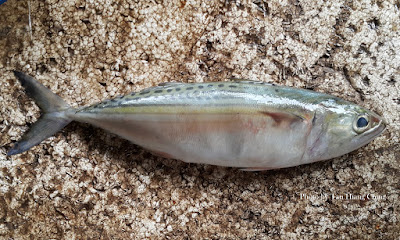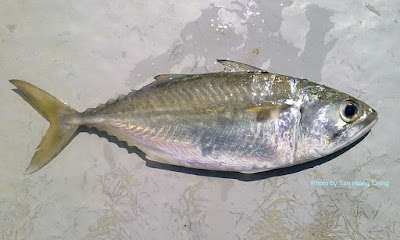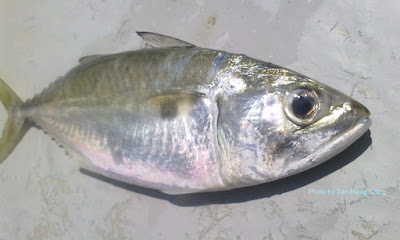Scombrids (Mackerel)
Tunas, mackerels, Spanish mackerels, albacore, bonitos, seerfishes and wahoo are the common names for the members of the Scombridae family. The family members are distinguished by having finlets behind their dorsal and anal fins, a deeply forked caudal fin, and at least 2 small keels on each side of caudal peduncle. Many species have a larger keel in between the small keels.
Members of the Scombridae are found in the tropical and subtropical seas around the world. There are 15 genera and 54 species worldwide. All of them are excellent food fishes. Many are of commercial importance and good sports fishes. Scientifically the family is divided into 2 subfamilies. The subfamily Scombrinae consist of 53 species and Gasterochismatinae consist of only one species. However, in general they can be divided according to their shape and behavior into 3 groups; Spanish mackerels, mackerels and tunas.
The mackerels shown in this page are from Rastrelliger (3 species) genus. They are the smaller scombrids where their length rarely exceeds 35 cm. They are mostly found near coastal waters and frequently occur in large schools. They feed mainly on zooplankton. They often swim with their mouth open to strain plankton from the water using their gill rakers.
Members of the Scombridae are found in the tropical and subtropical seas around the world. There are 15 genera and 54 species worldwide. All of them are excellent food fishes. Many are of commercial importance and good sports fishes. Scientifically the family is divided into 2 subfamilies. The subfamily Scombrinae consist of 53 species and Gasterochismatinae consist of only one species. However, in general they can be divided according to their shape and behavior into 3 groups; Spanish mackerels, mackerels and tunas.
The mackerels shown in this page are from Rastrelliger (3 species) genus. They are the smaller scombrids where their length rarely exceeds 35 cm. They are mostly found near coastal waters and frequently occur in large schools. They feed mainly on zooplankton. They often swim with their mouth open to strain plankton from the water using their gill rakers.
Scientific Name: Rastrelliger brachysoma (Bleeker, 1851)
English Name: Indo-pacific Mackerel, Short Mackerel, Short-bodied Mackerel
Chinese Name | 鱼类中文名: 甘望魚 (Gān wàng yú)
Malay Name | Bahasa Melayu Malaysia: Ikan Temenung, Temenong, Rumahan, Kembung Pelaling
Indonesian Name | Nama Indonesia: Ikan Kembung Perempuan, Kembung Bini, Kembung Satai, Kembang Pasang, Banjar, Bulus Bine, Rumah-rumah, Au-au
Thai Name | ชื่อสามัญภาษาไทย: ปลาทูสั้น (Plā thū s̄ận)
Local Hokkien: Kambong Hu, Bak Bong (for large size)
Main Identification Features: Body is deep and short.
Size: Maximum fork length 34.5 cm, commonly 20 cm.
Habitat and Ecology: Inshore pelagic. Forms schools of equally sized individuals, and feeds chiefly on microzooplankton with a high phytoplankton component.

Scientific Name: Rastrelliger faughni Matsui, 1967
English Name: Faughni Mackerel, Island Mackerel
Chinese Name | 鱼类中文名: 甘望魚 (Gān wàng yú)
Malay Name | Bahasa Melayu Malaysia: Ikan Temenung, Temenong, Rumahan, Mabong, Kembung Lampai
Indonesian Name | Nama Indonesia: Ikan Kembung Pulau
Thai Name | ชื่อสามัญภาษาไทย: ปลาทูปากจิ้งจก (Plā thū pākcîngck)
Local Hokkien: Kambong Hu, Mabong, Bak Bong (for large size)
Main Identification Features: Body is not deep. Dusky stripes running along sides of body.
Size: Maximum fork length is more than 20 cm.
Habitat and Ecology: Inshore pelagic. Forms schools of equally sized individuals, and feeds on the large zooplankton organisms.


Scientific Name: Rastrelliger kanagurta (Cuvier, 1816)
English Name: Indian Mackerel
Chinese Name | 鱼类中文名: 甘望魚 (Gān wàng yú)
Malay Name | Bahasa Melayu Malaysia: Ikan Temenung, Temenong, Rumahan, Mabong, Kembung Hitam, Kembung Borek
Indonesian Name | Nama Indonesia: Ikan Kembung Lelaki, Kembung Laki, Kombong Padi, Banyar, Gombong, Bulus Lake
Thai Name | ชื่อสามัญภาษาไทย: ปลาทูลัง (Plā thū lạng), ทูโม่ง (Thū mòng), โม่งลัง (Mòng lạng)
Local Hokkien: Kambong Hu, Mabong, Bak Bong (for large size)
Main Identification Features: Black spot near lower margin of pectoral fins.
Size: Maximum fork length 38 cm, commonly 25 cm.
Habitat and Ecology: Inshore pelagic. Forms schools of equally sized individuals, and feeds on phytoplankton and small zooplankton. Adult individuals feed on small crustaceans such as copepods, as well as fish, shrimp and squid.


English Name: Indo-pacific Mackerel, Short Mackerel, Short-bodied Mackerel
Chinese Name | 鱼类中文名: 甘望魚 (Gān wàng yú)
Malay Name | Bahasa Melayu Malaysia: Ikan Temenung, Temenong, Rumahan, Kembung Pelaling
Indonesian Name | Nama Indonesia: Ikan Kembung Perempuan, Kembung Bini, Kembung Satai, Kembang Pasang, Banjar, Bulus Bine, Rumah-rumah, Au-au
Thai Name | ชื่อสามัญภาษาไทย: ปลาทูสั้น (Plā thū s̄ận)
Local Hokkien: Kambong Hu, Bak Bong (for large size)
Main Identification Features: Body is deep and short.
Size: Maximum fork length 34.5 cm, commonly 20 cm.
Habitat and Ecology: Inshore pelagic. Forms schools of equally sized individuals, and feeds chiefly on microzooplankton with a high phytoplankton component.

Scientific Name: Rastrelliger faughni Matsui, 1967
English Name: Faughni Mackerel, Island Mackerel
Chinese Name | 鱼类中文名: 甘望魚 (Gān wàng yú)
Malay Name | Bahasa Melayu Malaysia: Ikan Temenung, Temenong, Rumahan, Mabong, Kembung Lampai
Indonesian Name | Nama Indonesia: Ikan Kembung Pulau
Thai Name | ชื่อสามัญภาษาไทย: ปลาทูปากจิ้งจก (Plā thū pākcîngck)
Local Hokkien: Kambong Hu, Mabong, Bak Bong (for large size)
Main Identification Features: Body is not deep. Dusky stripes running along sides of body.
Size: Maximum fork length is more than 20 cm.
Habitat and Ecology: Inshore pelagic. Forms schools of equally sized individuals, and feeds on the large zooplankton organisms.


Scientific Name: Rastrelliger kanagurta (Cuvier, 1816)
English Name: Indian Mackerel
Chinese Name | 鱼类中文名: 甘望魚 (Gān wàng yú)
Malay Name | Bahasa Melayu Malaysia: Ikan Temenung, Temenong, Rumahan, Mabong, Kembung Hitam, Kembung Borek
Indonesian Name | Nama Indonesia: Ikan Kembung Lelaki, Kembung Laki, Kombong Padi, Banyar, Gombong, Bulus Lake
Thai Name | ชื่อสามัญภาษาไทย: ปลาทูลัง (Plā thū lạng), ทูโม่ง (Thū mòng), โม่งลัง (Mòng lạng)
Local Hokkien: Kambong Hu, Mabong, Bak Bong (for large size)
Main Identification Features: Black spot near lower margin of pectoral fins.
Size: Maximum fork length 38 cm, commonly 25 cm.
Habitat and Ecology: Inshore pelagic. Forms schools of equally sized individuals, and feeds on phytoplankton and small zooplankton. Adult individuals feed on small crustaceans such as copepods, as well as fish, shrimp and squid.

